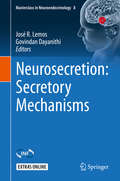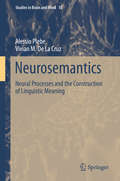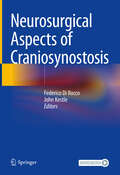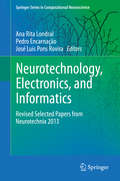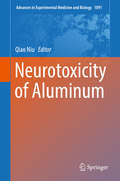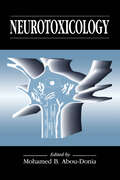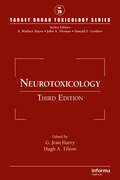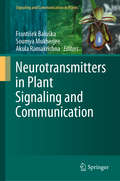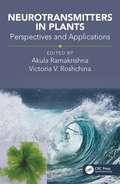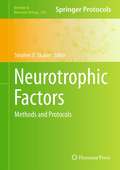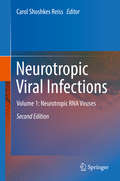- Table View
- List View
Neuroscientific Methods in Practice: Applications in Clinical Neuropsychology and Neuro-Forensic Psychology
by K. Jayasankara ReddyThis book presents an in-depth exploration of the convergence of neuroscience with clinical psychology, clinical neuropsychology, and forensic psychology, examining advanced methodologies, practical applications, and real-world case studies.K. Jayasankara Reddy provides a thorough examination of state-of-the-art neuroscientific methods and the revolutionary effects on both diagnosis and forensic inquiry. Reddy highlights the transformative impact of neuroimaging, neurophysiology, neuroelectrophysiology, and genetic analysis on our comprehension of brain function and behavior, using compelling case examples and empirical evidence. This book not only discusses methods but also critically examines ethical difficulties, merits, and challenges of the techniques, as well as the legal ramifications that may arise from the use of neuroscientific evidence in clinical and forensic settings. This book also highlights the need for a sophisticated comprehension of privacy issues, patient self-governance, and the use of neurobiological information within legal structures.Overall, it provides readers with the tools to negotiate complicated ethical landscapes while responsibly utilizing neuroscientific discoveries, advocating for a balanced approach that combines scientific rigor and ethical responsibility. This volume is an important resource for students, researchers, and practitioners of clinical neuropsychology, forensic psychology, and neuroscience.
Neurosecretion: Secretory Mechanisms (Masterclass in Neuroendocrinology #8)
by José R. Lemos Govindan DayanithiHow do electrical activity and calcium signals in neurons influence the secretion of peptide hormones? This volume presents the current state of knowledge regarding the electrical, calcium signaling and synaptic properties of neuroendocrine systems from both vertebrate and invertebrate systems. The contributions span in vivo and in vitro studies that address: state‐dependent plasticity, relevance of firing patterns, membrane properties, calcium flux (including dynamic imaging and homeostasis), and molecular mechanisms of exocytosis, including from non-neuronal secretory cells. The chapters focus not only on research results but also on how experiments are conducted using state-of-the-art techniques, and how the resulting data are interpreted.While there are many books on the secretory properties of neurons, this is the first to focus on the distinctive secretory properties of neuroendocrine neurons. Accordingly, it offers an important text for undergraduate and graduate neuroscience students, and will also appeal to established scientists and postdoctoral fellows. This is the eighth volume in the Masterclass in Neuroendocrinology series* - now a co-publication between Springer Nature and the INF (International Neuroendocrine Federation). *Volumes 1-7 published by Wiley
Neurosemantics
by Alessio Plebe Vivian M. De La CruzThis book examines the concept of " Neurosemantics", a term currently used in two different senses: the informational meaning of the physical processes in the neural circuits, and semantics in its classical sense, as the meaning of language, explained in terms of neural processes. The book explores this second sense of neurosemantics, yet in doing so, it addresses much of the first meaning as well. Divided into two parts, the book starts with a description and analysis of the mathematics of the brain, including computational units, representational mechanisms and algorithmic principles. This first part pays special attention to the neural architecture which has been used in developing models of neurosemantics. The second part of the book presents a collection of models, and describes each model reproducing specific aspects of the semantics of language. Some of these models target one of the core problems of semantics, the reference of nouns, and in particular of nouns with a strong perceptual characterization. Others address the semantics of predicates, with a detailed analysis of colour attributes. While this book represents a radical shift from traditional semantics, it still pursues a line of continuity that is based on the idea that meaning can be captured, and explained, by a sort of computation.
Neurosociology: Fundamentals and Current Findings (SpringerBriefs in Sociology)
by David D. FranksThis book offers an introduction to the fundamentals of neurosociology and presents the newest issues and findings in the field. It describes the evolution of the brain and its social nature. It examines the concept of knowing and what can be known, as well as the subjective sensations we experience. Next, it explores the ubiquitousness of New Unconsciousness and the latest conclusions about mirror neurons. Additional themes and concepts described are sex differences in the brain, imitation, determinism and agency.The book brings together neuroscience and sociology, two fields that are very different in terms of method, theory, tradition and practice. It does so building on the following premise: If our brains have been forged evolutionarily over the many centuries for social life, sociologists should have the opportunity, if not the duty, to know about it whatever the reservations of some who think that any approach that includes biology must be reductionistic.
Neurosteroid Effects in the Central Nervous System: The Role of the GABA-A Receptor (Frontiers in Neuroscience)
by Sheryl S. SmithPresenting a complete overview of the effects of steroid hormones in the brain and describing new methods for investigating these effects, this book discusses theories on steroid action in the central nervous system and the techniques for receptor localization and quantification and enzyme regulation. The author explores the use of transgenic/antisense strategies to determine sites and the cellular effects of steroid action in the brain. He covers steroid action on mood, cognition, sensorimotor action, neuroprotection, and plasticity, and describes methods using molecular, electrophysical, and behavioral techniques to link cellular mechanisms of steroid action with behavioral effects.
Neurosurgical Aspects of Craniosynostosis
by Federico Di Rocco John KestleThe aim of this book is to cover the domain of craniofacial surgery focusing on neurological and neurosurgical issues. It will offer neurosurgeons and allied specialists a practical way to manage these complex and common malformations in a timely and appropriate way. At the same time, they will be provided the knowledge necessary to understand the functional aspects of these diseases, their anatomical and dynamic impact on the underlying cerebral and vascular structures as well as the cerebrospinal fluid pathways, to overcome the limits of the mere morphological and esthetical correction. Written by experts in the field, the book will represent a reference resource not only for pediatric neurosurgeons and plastic and reconstructive maxillofacial surgeons, but also for all neurosurgeons, residents, and fellows working in this area.
Neuroteach: Brain Science and the Future of Education
by Glenn Whitman and Ian KelleherNeuroteach was therefore written to help solve the problem teachers and school leaders have in knowing how to bring the growing body of educational neuroscience research into the design of their schools, classrooms, and work with each individual student.
Neurotechnologies of the Self
by Jonna BrenninkmeijerTaking care of oneself is increasingly interpreted as taking care of one's brain. Apart from pills, books, food, and games for a better brain, people can also use neurotechnologies for self-improvement. This book explores how the use of brain devices to understand or improve the self changes people's subjectivity. This book describes how the effects of several brain devices were and are demonstrated; how brains and selves interact in the work of early brainwave scientists and contemporary practitioners; how users of neurofeedback (brainwave training) constitute a new mode of self that is extended with a brain and various other (physiological, psychological, material, and sometimes spiritual) entities, ∧ how clients, practitioners and other actors (computers, brain maps, brainwaves) perform a dance of agency during the neurofeedback process. Through these topics, Jonna Brenninkmeijer provides a historical, ethnographical, and theoretical exploration of the mode of being that is constituted when people use a brain device to improve themselves.
Neurotechnology and Direct Brain Communication: New insights and responsibilities concerning speechless but communicative subjects (Explorations in Cognitive Psychology)
by Michele Farisco Kathinka EversNeurotechnology and Direct Brain Communication focuses on recent neuroscientific investigations of infant brains and of patients with disorders of consciousness (DOC), both of which are at the forefront of contemporary neuroscience. The prospective use of neurotechnology to access mental states in these subjects, including neuroimaging, brain simulation, and brain computer interfaces, offers new opportunities for clinicians and researchers, but has also received specific attention from philosophical, scientific, ethical, and legal points of view. This book offers the first systematic assessment of these issues, investigating the tools neurotechnology offers to care for verbally non-communicative subjects and suggesting a multidisciplinary approach to the ethical and legal implications of ordinary and experimental practices. The book is divided into three parts: the first and second focus on the scientific and clinical implications of neurological tools for DOC patient and infant care. With reference to these developments, the third and final part presents the case for re-evaluating classical ethical and legal concepts, such as authority, informed consent, and privacy. Neurotechnology and Direct Brain Communication will appeal to researchers and postgraduate students in the fields of cognitive science, medical ethics, medical technology, and the philosophy of the mind. With implications for patient care, it will also be a useful resource for clinicians, medical centres, and health practitioners.
Neurotechnology and the End of Finitude (Posthumanities #45)
by Michael HaworthA bold philosophical investigation into technology and the limits of the human A daring, original work of philosophical speculation, Neurotechnology and the End of Finitude mounts a sustained investigation into the possibility that human beings may technologically overcome the transcendental limits of possible experience and envisages what such a transition would look like. Focusing on emergent neurotechnologies, which establish a direct channel of communication between brain and machine, Michael Haworth argues that such technologies intervene at the border between interiority and exteriority, offering the promise of immediacy and the possibility of the mind directly affecting the outside world or even other minds. Through detailed, targeted readings of Kant, Freud, Heidegger, Croce, Jung, and Derrida, Haworth explores the effect of this transformation on human creativity and our relationships with others. He pursues these questions across four distinct but interrelated spheres: the act of artistic creation and the potential for a technologically enabled coincidence of idea and object; the possibility of humanity achieving the infinite creativity that Kant attributed only to God; the relationship between the psyche and the external world in Freudian psychoanalysis and Jungian analytical psychology; and the viability and impact of techno-telepathic communication. Addressing readers interested in contemporary continental philosophy and philosophy of technology, media and communications, and science and technology studies, Neurotechnology and the End of Finitude critically envisions a plausible posthuman future.
Neurotechnology in National Security and Defense: Practical Considerations, Neuroethical Concerns (Advances in Neurotechnology)
by James GiordanoNeurotechnology in National Security and Defense: Practical Considerations, Neuroethical Concerns is the second volume in the Advances in Neurotechnology series. It specifically addresses the neuroethical, legal, and social issues arising from the use of neurotechnology in national security and defense agendas and applications. Of particular concer
Neurotechnology, Electronics, and Informatics
by Ana Rita Londral Pedro Encarnação José Luis Pons RoviraThe International Congress on Neurotechnology, Electronics, and Informatics (NEUROTECHNIX) took place in Algarve, Portugal in September of 2013. The congress provided a meeting point of academics and clinical and engineering professionals, promoting translational discussions on how research and technology can meet the needs of clinical practitioners and patients. NEUROTECHNIX emphasized research and application of neurotechnologies to various neurological disorders, including neuromuscular diseases, Parkinson's disease, developmental disorders, dementia, epilepsy, sleep disorders, Multiple Sclerosis, neuroinfections, brain tumors, stroke, traumatic brain injuries, Cerebral Palsy, spinal cord injury and vision and hearing disorders. Authors were invited to submit innovative research work that highlighted new advancements of neurotechnology. Papers describing case studies, advanced prototypes, systems, tools and techniques and general survey papers indicating future directions were encouraged. This book contains a limited selection of extended and revised versions of the best papers presented at the congress, by regular and keynote speakers.
Neurotechnology: Premises, Potential, and Problems (Advances in Neurotechnology)
by James GiordanoNew technologies that allow us to investigate mechanisms and functions of the brain have shown considerable promise in treating brain disease and injury. These emerging technologies also provide a means to assess and manipulate human consciousness, cognitions, emotions, and behaviors, bringing with them the potential to transform society. Neurotech
Neurotheology: How Science Can Enlighten Us About Spirituality (Routledge Science And Religion)
by Andrew NewbergReligion is often cast in opposition to science. Yet both are deeply rooted in the inner workings of the human brain. With the advent of the modern cognitive neurosciences, the scientific study of religious and spiritual phenomena has become far more sophisticated and wide-ranging. What might brain scans of people in prayer, in meditation, or under the influence of psychoactive substances teach us about religious and spiritual beliefs? Are religion and spirituality reducible to neurological processes, or might there be aspects that, at least for now, transcend scientific claims?In this book, Andrew Newberg explores the latest findings of neurotheology, the multidisciplinary field linking neuroscience with religious and spiritual phenomena. He investigates some of the most controversial—and potentially transformative—implications of a neurotheological approach for the truth claims of religion and our understanding of minds and brains. Newberg leads readers on a tour through key intersections of neuroscience and theology, including the potential evolutionary basis of religion; the psychology of religion, including mental health and brain pathology; the neuroscience of myths, rituals, and mystical experiences; how studies of altered states of consciousness shed new light on the mind-brain relationship; and what neurotheology can tell us about free will. When brain science and religious experience are considered together in an integrated approach, Newberg shows, we might come closer to a fuller understanding of the deepest questions.
Neurotoxicity of Aluminum
by Qiao NiuThis book reviews the scientific literature and the authors’ own research linking aluminum neurotoxicity with cognitive impairment and Alzheimer’s disease (AD). It focuses on aluminum levels in the brain, region-specific and subcellular distribution, its relation to neurofibrillary tangles and amyloid beta—the pathological features of AD, and the possible mechanism of aluminum inducing these pathological features. Further, the book stresses the importance of aluminum’s complex speciation chemistry in relation to biology, and details aluminum’s mechanism in oxidative stress and cell death, especially in connection with apoptosis and necroptosis. The electrophysiological variation and synaptic plasticity induced by aluminum are covered, while the metal’s debatable role in AD and the cross-talk between aluminum and genetic susceptibility are also discussed, and more recently the relationship between aluminum-induced epigenetic modification on DNA and non-coding RNAs and neuron death and synaptic impairment.The second edition updates eight chapters according to the most recent researches. Content about aluminum-induced AD-like pathological features, neurotoxic effects of aluminum and aluminum alloy nanoparticles(TBD) and alumina nanoparticles induced neurotoxic and neurodevelopmental toxic effects is also added. In closing, this book provides readers with a systematic summary of aluminum neurotoxicity.
Neurotoxicity of Aluminum (Advances in Experimental Medicine and Biology #1091)
by Qiao NiuThis book reviews the scientific literature and the authors’ own research linking aluminum neurotoxicity with cognitive impairment and Alzheimer’s disease (AD). It focuses on aluminum levels in the brain, region-specific and subcellular distribution, and its relation to neurofibrillary tangles and amyloid beta. Further, the book stresses the importance of aluminum’s complex speciation chemistry in relation to biology, and details aluminum’s mechanism in oxidative stress and cell death, especially in connection with apoptosis and necroptosis. The electrophysiological variation and synaptic plasticity induced by aluminum are covered, while the metal’s debatable role in AD and the cross-talk between aluminum and genetic susceptibility are also discussed. In closing, the book reviews the neurotoxic effects of aluminum and its important role in the pathogenesis of AD. Given its depth of coverage, the book provides readers with a systematic summary of aluminum neurotoxicity.
Neurotoxicology
by Mohamed B. Abou-DoniaNeurotoxicology provides a thorough understanding of neurotoxicology through its integration of multilateral ideas covering several disciplines, including chemistry, biochemistry, anatomy, physiology, and pathology. It discusses neurotoxic agents, describes the methods for studying neurotoxic actions, covers factors affecting neurotoxicity, and inc
Neurotoxicology (Target Organ Toxicology Series)
by Hugh A. Tilson G. Jean HarryThis new edition presents an integrated approach to neurotoxicology, the study of organisms' responses to changes in their environment and how interruption of the flow of information by chemical exposure causes a wide range of effects - from learning deficits, sensory disturbances in the extremities, and muscle weakness to seizures and signs simila
Neurotransmitter Receptors in Actions of Antipsychotic Medications (Handbooks in Pharmacology and Toxicology)
by Michael S. LidowYears of extensive investigation into neurophysiology, neurochemistry, and behavioral pharmacology have produced an understanding of antipsychotic medication action that is much more refined than the original dopamine hypothesis. New perspectives offer an array of novel drugs - drugs that pose a lower risk of developing tardive dyskinesia, have few
Neurotransmitters in Plant Signaling and Communication (Signaling and Communication in Plants)
by František Baluška Akula Ramakrishna Soumya MukherjeeThis book provides a comprehensive update on the recent developments concerning the role of plant neurotransmitters in signaling and communication. Physiological investigations over the past few decades have demonstrated that plants employ neurotransmitters in various signaling pathways. Plant-based neurotransmitters (serotonin, melatonin, dopamine, acetylcholine, and GABA) share biochemical similarities with those in animal systems in terms of their chemical nature and biochemical pathways. Plant–environment interaction associated with abiotic stress management, growth modulation, flowering, circadian rhythm, fruit ripening, and allelopathic interactions are a major focus of research in the field, and recent advances in genomic, trascriptomic, and metabolomic approaches have resulted in the deciphering of the molecular mechanisms associated with various neurotransmitters in plants. Other current and potential areas of investigation include the putative phytohormone phytomelatonin, and receptor-mediated signaling in plant neurotransmitters. Providing an up-to-date overview of molecular crosstalk mechanisms between various neurotransmitters, the book offers essential insights to help readers gain a better understanding of the physiology of plant signaling and communication with the environment.
Neurotransmitters in Plants: Perspectives and Applications
by Akula Ramakrishna Victoria Vladimirovna RoshchinaKey features: Presents the latest trends and developments of neuromediators in plants Provides in-depth coverage of plants enriched in neurotransmitters (especially serotonin, melatonin, and dopamine) and how they are used in medicine, pharmacy, and food nutrition Discusses the physiological role of the neurotransmitters (biomediators) in non-nervous systems including the analysis of effects on the growth and development and stress defense Covers the occurrence of the substances that act in human and animal nervous system in plants as a phenomenon of the universal irritability feature for biologists Reveals the occurrence and possible physiological functions of biogenic amines in plants, food, and human health New scientific data confirm the origin of neurotransmitters in the ancient ocean, whose inhabitants use the compounds in their relationships. One example is the algae Ulvaria, whose image is represented on the cover. During evolution, plant and microbial cells stored the neurotransmitters that play multifunctional roles today. Researchers have paid special attention to their functions in plants, the oxygen well of our planet. This book provides powerful tools for both analyzing and manipulating organisms, considering the functions of neurotransmitters in plant cells and the practical application of knowledge about acetylcholine, catecholamines, serotonin, melatonin, histamine, gamma-aminobutyric acid and glutamine for ecology, agriculture, medicine and food industries. Neurotransmitters in Plants: Perspectives and Applications presents information on: the location and biosynthesis where neurotransmitters occur the molecular biology of some enzymes participating in the process their role in vivo and in vitro processes their functions in plant environmental adaptation in plants their role in enriching the food and medicinal value of plants.
Neurotrophic Factors
by Stephen D SkaperNervous system development evolves from the well-orchestrated processes of neural induction, cell proliferation, differentiation, cell migration, survival, and synapse formation. Among these environmental cues, neurotrophic factors are secreted proteins that promote neurite outgrowth, neuronal cell differentiation and survival both in vivo and in vitro. Nerve growth factor (NGF) is the founding and best characterized member of the neurotrophin family of neurotrophic polypeptides. Neurotrophic Factors: Methods and Protocols presents a selection of protocols and procedures which make use of cellular, tissue, and whole animal models which can be applied to the investigation of neurotrophic factors and other agents impacting on these systems. Chapters cover a wide-range of topics such as dealing with the culture of neurons and glia from the central and peripheral nervous systems, neuron-glia co-culture models, and cell-based assays for the evaluation of neuroprotective molecules, as well as assays which can be applied to the study of agents with neuroregenerative potential. Protocols describing viral- and nanoparticle-based delivery methods to neural cells are also presented, following by chapters dealing with organotypic slice culture protocols. Lastly, several chapters are dedicated to in vivo lesion models of relevance to nervous system pathology, which can be applied to the investigation of neurotrophic factors and peptides. Written in the successful Methods in Molecular BiologyTM series format, chapters include introductions to their respective topics, lists of the necessary materials and reagents, step-by-step, readily reproducible protocols, and notes on troubleshooting and avoiding known pitfalls. Authoritative and easily accessible, Neurotrophic Factors: Methods and Protocols seeks to serve both professionals and novices alike with its well-honed methodologies in an effort to further our knowledge of what has been described as the last frontier of science.
Neurotrophic Factors
by Stephen D. SkaperNervous system development evolves from the well-orchestrated processes of neural induction, cell proliferation, differentiation, cell migration, survival, and synapse formation. Among these environmental cues, neurotrophic factors are secreted proteins that promote neurite outgrowth, neuronal cell differentiation and survival both in vivo and in vitro. Nerve growth factor (NGF) is the founding and best characterized member of the neurotrophin family of neurotrophic polypeptides. Neurotrophic Factors: Methods and Protocols presents a selection of protocols and procedures which make use of cellular, tissue, and whole animal models which can be applied to the investigation of neurotrophic factors and other agents impacting on these systems. Chapters cover a wide-range of topics such as dealing with the culture of neurons and glia from the central and peripheral nervous systems, neuron-glia co-culture models, and cell-based assays for the evaluation of neuroprotective molecules, as well as assays which can be applied to the study of agents with neuroregenerative potential. Protocols describing viral- and nanoparticle-based delivery methods to neural cells are also presented, following by chapters dealing with organotypic slice culture protocols. Lastly, several chapters are dedicated to in vivo lesion models of relevance to nervous system pathology, which can be applied to the investigation of neurotrophic factors and peptides. Written in the successful Methods in Molecular Biology(tm) series format, chapters include introductions to their respective topics, lists of the necessary materials and reagents, step-by-step, readily reproducible protocols, and notes on troubleshooting and avoiding known pitfalls. Authoritative and easily accessible, Neurotrophic Factors: Methods and Protocols seeks to serve both professionals and novices alike with its well-honed methodologies in an effort to further our knowledge of what has been described as the last frontier of science.
Neurotrophic Natural Products (Progress in the Chemistry of Organic Natural Products #123)
by A. Douglas Kinghorn Heinz Falk Simon Gibbons Yoshinori Asakawa Ji-Kai Liu Verena M. DirschThis book deals with neurotrophins (NGF, BDNF, NT3, NT4), which can decrease cell death, induce differentiation, as well as sustain the structure and function of neurons. This makes neurotrophins potential therapeutic agents for the treatment of neurodegenerative disorders. However, these proteins have so far been ineffective in clinical trials mostly because they cannot pass the blood-brain barrier owing to their high-molecular weights. Consequently, small molecules that mimic neurotrophins and stimulate the synthesis of endogenous neurotrophins or enhance their neurotrophic actions are expected to be promising alternatives. Small-molecule natural products, which have been used in dietary functional foods or in traditional medicine over the course of human history, have potential to be developed as new therapeutic agents against neurodegenerative conditions such as Alzheimer’s disease. In this book, the authors introduce a variety of natural products possessing neurotrophic properties such as neurogenesis, neurite outgrowth promotion (neuritogenesis), and neuroprotection and focus on the chemistry and biology of several neurotrophic natural products.
Neurotropic Viral Infections
by Carol Shoshkes ReissThis second edition is a comprehensive study of the viruses that affect the brain and the central nervous system. Along with a focus on the viruses themselves, it addresses the diseases they cause, current treatments and preventive measures. Also discussed are the unique aspects of how viruses cause disease and why certain hosts are more susceptible (e. g. , polymorphisms, age, co-morbidities). Because there are 29 cutting edge chapters, written by experts in the fields, Neurotropic Viral Infections has been divided into two separate volumes. Volume 1, Neurotropic RNA Viruses, includes 14 chapters on RNA viruses that cause human disease of the central nervous system ranging from Bornavirus to polio to West Nile. Volume 2, Neurotropic Retroviruses, DNA Viruses, Immunity and Transmission, includes 15 chapters divided into two parts. Part 1 includes 7 chapters on retroviruses and DNA viruses that cause human disease of the central nervous system ranging from HIV to varicella zoster virus. Part 2 includes chapters on transmission of these viruses by transplantation, bites by bats and insects, clinical management of the infections, and beneficial uses of attenuated viruses. Neurotropic Viral Infections is a unique resource, bridging basic, clinical, and translational approaches.

